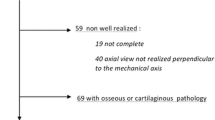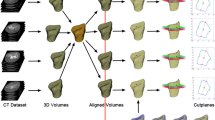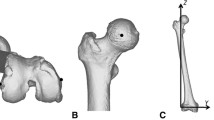Abstract
Introduction
This study analysed femoral curvature in a population from Belgium in conjunction with other morphological characteristics by the use of three-dimensional (3D) quadric surfaces (QS) modelled from the bone surface.
Methods
3D models were created from computed tomography data of 75 femoral modern human bones. Anatomical landmarks (ALs) were palpated in specific bony areas of the femur (shaft, condyles, neck and head). QS were then created from the surface vertices which enclose these ALs. The diaphyseal shaft was divided into five QS shapes to analyse curvature in different parts of the shaft.
Results
Femoral bending differs in different parts of the diaphyseal shaft. The greatest degree of curvature was found in the distal shaft (mean 4.5° range 0.2°–10°) followed by the proximal (mean 4.4° range 1.5°–10.2°), proximal intermediate (mean 3.7° range 0.9°–7.9°) and distal intermediate (mean 1.8° range 0.2°–5.6°) shaft sections. The proximal and distal angles were significantly more bowed than the intermediate proximal and the intermediate distal angle. There was no significant difference between the proximal and distal angle. No significant correlations were found between morphological characteristics and femoral curvature. An extremely large variability of femoral curvature with several bones displaying very high or low degrees of femoral curvature was also found.
Conclusion
3D QS fitting enables the creation of accurate models which can discriminate between different patterns in similar curvatures and demonstrates there is a clear difference between curvature in different parts of the shaft.




Similar content being viewed by others
References
Bruns W, Bruce M, Prescott G, Maffulli N (2002) Temporal trends in femoral curvature and length in medieval and modern Scotland. Am J Phys Anthropol 119(3):224–230. doi:10.1002/ajpa.10113
Buford WL Jr, Turnbow BJ, Gugala Z, Lindsey RW (2014) Three-dimensional computed tomography-based modeling of sagittal cadaveric femoral bowing and implications for intramedullary nailing. J Orthop Trauma 28(1):10–16. doi:10.1097/bot.0000000000000019
Chang SM, Song DL, Ma Z, Tao YL, Chen WL, Zhang LZ, Wang X (2014) Mismatch of the short straight cephalomedullary nail (PFNA-II) with the anterior bow of the femur in an Asian population. J Orthop Trauma 28(1):17–22. doi:10.1097/bot.0000000000000022
Chantarapanich N, Mahaisavariya B, Siribodhi P, Kriskrai S (2011) Geometric mismatch analysis of retrograde nail in the Asian femur. Surg Radiol Anat 33(9):755–761
Chung BJ, Kang YG, Chang CB, Kim SJ, Kim TK (2009) Differences between sagittal femoral mechanical and distal reference axes should be considered in navigated TKA. Clin Orthop Relat Res 467(9):2403–2413. doi:10.1007/s11999-009-0762-5
Cooke TD, Sled EA, Scudamore RA (2007) Frontal plane knee alignment: a call for standardized measurement. J Rheumatol 34(9):1796–1801
De Groote I (2011) Femoral curvature in Neanderthals and modern humans: a 3D geometric morphometric analysis. J Hum Evol 60(5):540–548. doi:10.1016/j.jhevol.2010.09.009
De Groote I, Lockwood CA, Aiello LC (2010) Technical note: A new method for measuring long bone curvature using 3D landmarks and semi-landmarks. Am J Phys Anthropol 119 141 (4):658-664. doi:10.1002/ajpa.21225
Eberly D (2008) Distance from a point to an ellipsoid. (http://www.geometrictools.com/Documentation/DistancePointEllipseEllipsoid.pdf). Accessed 15 June 2010
Egol KA, Chang EY, Cvitkovic J, Kummer FJ, Koval KJ (2004) Mismatch of current intramedullary nails with the anterior bow of the femur. J Orthop Trauma 18(7):410–415
Gilbert BM (1976) Anterior femoral curvature: Its probable basis and utility as a criterion of racial assessment. Am J Phys Anthropol 45(3):601–604. doi:10.1002/ajpa.1330450326
Harma A, Germen B, Karakas H, Elmali N, Inan M (2005) The comparison of femoral curves and curves of contemporary intramedullary nails. Surg Radiol Anat 27(6):502–506
Harper MC, Carson WL (1987) Curvature of the femur and the proximal entry point for an intramedullary rod. Clin Orthop Relat Res 220:155–161
Jacq JJ, Roux C (2003) Geodesic morphometry with applications to 3-D morpho-functional anatomy. Proc IEEE 91(10):1680–1698. doi:10.1109/JPROC.2003.817863
Karakas H, Harma A (2012) Femoral shaft bowing with age: a digital radiological study of anatolian caucasian adults. Diagn Interv Radiol 14:29–32
Lu Z-H, Yu J-K, Chen L-X, Gong X, Wang Y-J, Leung KKM (2012) Computed tomographic measurement of gender differences in bowing of the sagittal femoral shaft in persons older than 50 years. J Arthroplasty 27(6):1216–1220. doi:10.1016/j.arth.2011.12.024
Murray PDF (1936) Bones. A study of the development and structure of the vertebrate skeleton. Cambridge University Press, London
Murray PDF, Selby D (1930) Intrinsic and extrinsic factors in the primary development of the skeleton. Roux Arch 122:629–662
Ostrum RF, Levy MS (2005) Penetration of the distal femoral anterior cortex during intramedullary nailing for subtrochanteric fractures: a report of three cases. J Orthop Trauma 19(9):656–660
Scolaro JA, Endress C, Mehta S (2013) Prevention of cortical breach during placement of an antegrade intramedullary femoral nail. Orthopedics 36(9):688–692
Seo JG, Kim BK, Moon YW, Kim JH, Yoon BH, Ahn TK, Lee DH (2009) Bony landmarks for determining the mechanical axis of the femur in the sagittal plane during total knee arthroplasty. Clin Orthop Surg 1(3):128–131. doi:10.4055/cios.2009.1.3.128
Shackelford LL, Trinkaus E (2002) Late pleistocene human femoral diaphyseal curvature. Am J Phys Anthropol 119(118):359–370
Sholukha V, Chapman T, Salvia P, Moiseev F, Euran F, Rooze M (2010) Femur shape prediction by multiple regression based on quadric surface fitting. J Biomech 44(4):712–718. doi:10.1016/j.jbiomech.2010.10.039
Stewart TD (1962) Anterior femoral curvature: its utility for race identification. Hum Biol 34:49–62
Tang W, Chiu K, Kwan M, Ng T, Yau W (2005) Sagittal bowing of the distal femur in Chinese patients who require total knee arthroplasty. J Orthop Res 23(1):41–45
Twiesselmann F (1961) Le fémur néanderthalien de Fond-de-Forêt(Province de Liège). Mém Inst Roy Sci Nat, Belg 148
Van Sint Jan S (2007) Color atlas of skeletal landmark definitions: guidelines for reproducible manual and virtual palpations. Churchill Livingstone Elsevier, Edinburgh
Walensky NA (1965) A study of anterior femoral curvature in man. Anat Rec 151(4):559–570. doi:10.1002/ar.1091510406
Wolff J (1986) The law of bone remodelling (trans: Maquet P, Furlong R). Springer, New York
Yehyawi TM, Callaghan JJ, Pedersen DR, O’Rourke MR, Liu SS (2007) Variances in sagittal femoral shaft bowing in patients undergoing TKA. Clin Orthop Relat Res 464:99–104
Zhang S, Zhang K, Wang Y, Feng W, Wang B, Yu B (2013) Using three-dimensional computational modeling to compare the geometrical fitness of two kinds of proximal femoral intramedullary nail for Chinese femur. Sci World J 2013:978485. doi:10.1155/2013/9784851
Acknowledgments
The authors thank Mr. Hakim Bajou (LABO, ULB) for his technical assistance in scanning the bone material. We thank François Euran for his assistance in palpation of landmarks. We thank Bruno Bonnechère for his assistance with statistics. The research was performed as part of a doctorate financed by the Belgian Federal Public Planning Service Science Policy (BELSPO, Action 2).
Conflict of interest
The authors declare that they have no conflict of interest.
Author information
Authors and Affiliations
Corresponding author
Rights and permissions
About this article
Cite this article
Chapman, T., Sholukha, V., Semal, P. et al. Femoral curvature variability in modern humans using three-dimensional quadric surface fitting. Surg Radiol Anat 37, 1169–1177 (2015). https://doi.org/10.1007/s00276-015-1495-7
Received:
Accepted:
Published:
Issue Date:
DOI: https://doi.org/10.1007/s00276-015-1495-7




